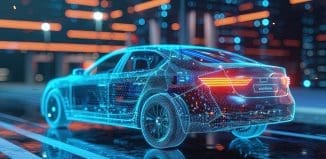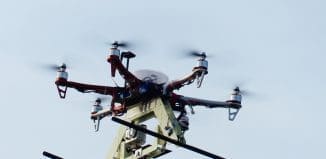This post is also available in:  עברית (Hebrew)
עברית (Hebrew)
Velodyne has developed and produced a High Definition Lidar (HDL) sensor designed to satisfy the demands for autonomous vehicle navigation, stationary and mobile surveying, mapping, industrial use and other applications. The Velodyne HDL unit provides 360-degree azimuth field of view and 26.5-degree elevation field of view, up to 15 Hz frame refresh rate, and a rich point cloud populated at a rate of one million points per second.
Hypertech is now representing Velodyne in the Israeli market.
The use of light pulses to measure distance is well known. The basic concept is to first emit a light pulse, typically using a laser diode. The light travels until it hits a target, when a portion of the light energy is reflected back towards the emitter. A detector mounted near the emitter detects this return signal, and the time difference between the emitted and detected pulse determines the distance of the target.
When this pulsing distance measurement system is somehow actuated, a multitude of points (called a “point cloud”) can be collected If no targets are present, then the light would never return. If the light was pointed downward, then the ground would provide some signal return. If a target was positioned within this point cloud, a notch would be seen in the rendered data. The distance and width of the target could be determined from this notch. When this collection of points is rendered, the point cloud begins to resemble a picture. The denser the point cloud the richer the picture becomes.
Velodyne has developed and produced a patented High Definition Lidar sensor, the HDL-64E, designed to satisfy the demands for mobile sensing applications.
The HDL-64E is the second generation laser sensor produced by Velodyne. The first generation prototype unit was used in the 2005 DARPA Challenge as part of Team Digital Auto Drive (DAD) where it enabled the Team DAD Toyota Tundra to complete 25 miles of the course before suffering a non-sensor-related mechanical failure. As a result of this success and the capabilities demonstrated by this sensor, including resolution, range and output data rate, the HDL-64E has been purchased and incorporated into over 12 teams’ autonomous navigation system designs for the 2007 DARPA Urban Challenge.
Velodyne’s HDL-64E is a High Definition Lidar capable of acquiring a large volume of high resolution 3-D data. The HDL-64E features a unique combination of high resolution, broad field of view, high point cloud density and an output data rate superior to any available Lidar sensor in the marketplace today. As such, it is the ideal building block for applications such as autonomous vehicle navigation, infrastructure surveying and mapping display and retrieval, as well as many other applications requiring 3-D data collection.































